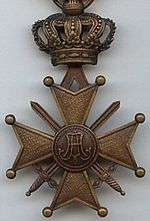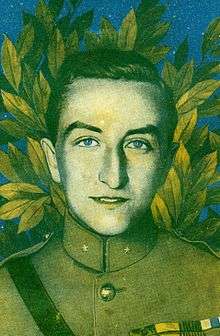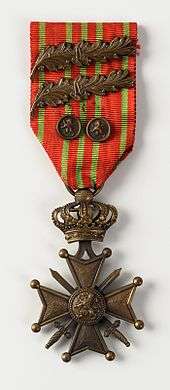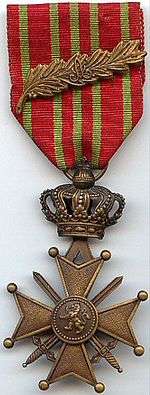Croix de guerre (Belgium)
| Croix de guerre | |
|---|---|
|
World War I Croix de guerre with Palm (obverse) | |
| Country |
|
| Type | Military decoration |
| Eligibility | Belgians and military personnel of allied forces |
| Awarded for | Bravery in the face of the enemy |
| Statistics | |
| Established |
25 October 1915 (World War I) 20 July 1940 (World War II) 3 April 1954 (Future wars) |
|
Ribbon bar for World War I Ribbon bar for World War II Ribbon bar for 1954–present | |




The Croix de guerre ("War Cross"; Dutch: Oorlogskruis; German: Kriegskreuz), is a military decoration of the Kingdom of Belgium established by royal decree on 25 October 1915.[1] It was primarily awarded for bravery or other military virtue on the battlefield. The award was reestablished on 20 July 1940 by the Belgian government in exile for recognition of bravery and military virtue during World War II.[2] The post-1940 decoration could also be awarded to units that were cited. The decoration was again reestablished by royal decree on 3 April 1954 for award during future conflicts.[3]
World War I
Award statute
The World War I Croix de guerre was established by royal decree on 25 October 1915 as an award for bravery or other military virtue on the battlefield. It was only awarded to individuals. The Croix de guerre was not only awarded for bravery but also for three years or more of service on the front line, or for good conduct on the battlefield. It was also awarded to volunteers older than 40 or younger than 16 after a minimum of 18 months of service, to escaped prisoners of war rejoining the armed forces, and to military personnel who were placed on inactive duty because of injury.[1]
Award description
The World War I Croix de guerre was a 40mm wide bronze Maltese cross with 3mm in diameter balls at its eight points. It had a 14mm in diameter central medallion bearing the relief image of a "lion rampant" on its obverse and the royal cypher of King Albert I on its reverse. Two 37mm long crossed swords point upwards between it arms. A 14mm high "inverted V" between the two points of the top cross arm is secured to the inside of a 25mm wide by 25mm high royal crown, the ribbon's suspension ring passes through the top orb of the crown giving the cross a total height of 65mm.[1]
The World War I Croix de guerre's ribbon is red with five 2mm wide light green longitudinal stripes, three at the center separated by 3mm and one on each side 3mm from the edges.
When the person being awarded the Croix de guerre was mentioned in despatches, this distinction was denoted by a device worn on the ribbon, either a small lion or a palm adorned with the monogram "A" (for Albert I):[1]
- Bronze lion: regimental level
- Silver lion: brigade level
- Gold lion: divisional level
- Bronze palm: Army level
- Silver palm: five bronze palms
- Gold palm: five silver palms
When awarded posthumously, the ribbon of the Croix de guerre was adorned with a narrow black enamel bar.[1]
Notable recipients of the 1914–1918 Croix de guerre (partial list)

The individuals listed below were awarded the World War I Croix de guerre:[4]
- Sergeant William Mabbott [1st Battalion North Staffordshire] resident of Uttoxeter, Staffs and Mansfield Woodhouse, Notts. 1991-1928
- Lieutenant Colonel James Neville Marshall (Irish Guards)
- Aviator Lieutenant Colonel Baron Willy Coppens
- Sapper Lance Corporal Percy Smith
- RSM Henry James Farley
- Lieutenant General Alphonse Ferdinand Tromme
- Cavalry Lieutenant General Marcel Jooris
- Major General Maurice Jacmart
- Lieutenant General Jean-Baptiste Piron
- Lieutenant General Jules Joseph Pire
- Cavalry Lieutenant General Sir Maximilien de Neve de Roden
- Cavalry Lieutenant General Baron Victor Van Strijdonck de Burkel
- Lieutenant General Georges Deffontaine
- Lieutenant General Alphonse Verstraete
- Lieutenant General Baron Raoul de Hennin de Boussu-Walcourt
- Lieutenant General Joseph Leroy
- Cavalry Lieutenant General Jules De Boeck
- Lieutenant General Fernand Vanderhaeghen
- Lieutenant General Robert Oor
- Lieutenant General Libert Elie Thomas
- Lieutenant General Léon Bievez
- Cavalry Major General Baron Beaudoin de Maere d’Aertrycke
- Major General Lucien Van Hoof
- Major General Jean Buysse
- Major General Paul Jacques
- Major General Alexis Grégoire
- Police Lieutenant General Louis Joseph Leroy
- Police Lieutenant General Oscar-Eugène Dethise
- Chaplain General Louis Kerremans
- Lieutenant General Harry Jungbluth
- Cavalry Lieutenant General Baron Albert du Roy de Blicquy
- Lieutenant General knight Antonin de Selliers de Moranville
- Lieutenant General Félix Wielemans
- Lieutenant General Baron Louis de Ryckel
- Lieutenant General Baron Émile Dossin de Saint-Georges
- Lieutenant General Baron Honoré Drubbel
- Lieutenant General Count Gérard-Mathieu Leman
- Lieutenant General Victor Bertrand
- Lieutenant General Joseph Jacquet
- Lieutenant General Baron Jules Jacques de Dixmude
- Lieutenant General Georges Guiette
- Lieutenant General Albert Lantonnois van Rode
- Lieutenant General Baron Armand de Ceuninck
- Lieutenant General Aloïs Biebuyck
- Cavalry Lieutenant General Baron Léon de Witte de Haelen
- Cavalry Lieutenant General Vicount Victor Buffin de Chosal
- Cavalry Lieutenant General Jules De Blauwe
- Major General Doctor Antoine Depage
- ′Major General Baron Edouard Empain
- Commandant Kristian Løken
- Lieutenant Charles Nungesser
- Georges Lemaître
- Sergeant Edwin Morrell
- Sergeant Archie Barwick
- Charles E. Morris M.M.
- Private Richard Reading (Corps de Mitrailleuses), Chevalier of the Order of Leopold
World War II
Award statute



The World War II Croix de guerre was established on 20 July 1940 by the Belgian government in exile, it differed from the World War I version in its statute and slight changes to the reverse of the central medallion and the ribbon.[2]
It was still mainly awarded to individuals, but was now also authorized as a unit award. A war cross being presented to a unit was denoted by a ribbon of the war cross being affixed to the unit colours[2]
The Belgian fourragère was awarded by the Belgian Government to a unit that was cited twice. Award of the fourragère was not automatic and required a specific decree of the Belgian Government. The fourragère is in the same colours as the ribbon of the World War II Croix de guerre. The Belgian fourragère was only worn by those who were members of the unit at the time of the award.
Award description
The World War II Croix de guerre was constructed in the same dimensions as its World War I predecessor, the only real difference being the royal cypher of King Leopold III on its reverse. The new ribbon was still red with light green stripes but there were now six, 1mm wide, and positioned three on each side 2mm apart beginning 2mm from the edge of the ribbon.[2]
The same ribbon devices were used as in World War I except the palms were now adorned with the monogram "L" (for Leopold III).[2]
Notable recipients of the 1940–1945 Croix de guerre (partial list)
The individuals listed below were awarded the World War II Croix de guerre:[5]
- Lieutenant General Albert Baron Crahay
- Lieutenant General Roger Dewandre
- Lieutenant General Ernest Engelen
- Aviator Lieutenant General Armand Crekillie
- Divisional Admiral Léon Lurquin
- Aviator Vice Admiral Sir André Schlim
- Lieutenant General Jean-Baptiste Piron
- Lieutenant General Jules Joseph Pire
- Cavalry Lieutenant General Sir Maximilien de Neve de Roden
- Cavalry Lieutenant General Baron Victor Van Strijdonck de Burkel
- Lieutenant General Georges Deffontaine
- Major General Baron Georges Danloy
- Lieutenant General Baron Raoul de Hennin de Boussu-Walcourt
- Cavalry Lieutenant General Jules De Boeck
- Lieutenant General Robert Oor
- Cavalry Major General Baron Beaudoin de Maere d’Aertrycke
- Commodore Georges Timmermans
- Count Charles of Limburg Stirum
Notable foreign recipients of the 1940–1945 Croix de guerre (partial list)
- General George Patton (USA)
- Field Marshal Bernard Montgomery (UK)
- General Harry Crerar (Canada)
- Prince Bernhard of Lippe-Biesterfeld (Netherlands)
- Colonel Whitfield Jack (USA)
- First Lieutenant Audie Murphy (USA)
- Major Richard D. "Dick" Winters (USA)
- Christopher Peto (UK)
- General Carl Spaatz (USA)
- William P. Straitiff Sgt. (USA)
Post 1954 variant


Award statute
On 3 April 1954, the Belgian government re-established the Croix de guerre but this time without any reference to a specific conflict. This decoration is intended to be awarded in a manner akin the World War II statute during potential future wars. The 1954 Croix de guerre has not yet been awarded.[3]
Award description
The post-1954 (or current) Croix de guerre is similar to the previous variants but with a different reverse center medallion now bearing the Coat of arms of Belgium in lieu of a royal monogram.[3]
The ribbon is a colour reversal of the World War II Croix de guerre ribbon, green with three narrow 1mm wide red stripes 2mm apart on each side beginning 2mm from the edge.[3]
See also
- Croix de guerre (France)
- Croix de guerre 1914–1918 (France)
- Croix de guerre 1939–1945 (France)
- List of Orders, Decorations and Medals of the Kingdom of Belgium
References
- 1 2 3 4 5 "Royal decree of 25 October 1915 creating the Croix de guerre". Belgian Defence Ministry. 1915-10-25.
- 1 2 3 4 5 "Decree of 20 July 1940 re establishing the Croix de guerre". Belgian Defence Ministry. 1940-07-20.
- 1 2 3 4 "Royal decree of 3 April 1954 re establishing the Croix de guerre". Belgian Defence Ministry. 1954-04-03.
- ↑ "Recipients of the WWI Croix de guerre compiled from the ARS MORIENDI web site" (in French). ARS MORIENDI. 2012-07-06. Retrieved 2012-09-09.
- ↑ "Recipients of the WW2 Croix de guerre compiled from the ARS MORIENDI web site" (in French). ARS MORIENDI. 2012-07-06. Retrieved 2012-09-09.
Other sources
- Quinot H., 1950, Recueil illustré des décorations belges et congolaises, 4e Edition. (Hasselt)
- Cornet R., 1982, Recueil des dispositions légales et réglementaires régissant les ordres nationaux belges. 2e Ed. N.pl., (Brussels)
- Borné A.C., 1985, Distinctions honorifiques de la Belgique, 1830–1985 (Brussels)
- Paul Hieronymussen, 1967, Orders Medals and Decorations of Britain and Europe in colour, 2nd Ed. 1970. (London)
External links
- Croix De Guerre, Belgium
- HET OORLOGSKRUIS '14–'18 (Dutch)
- Les Décorations belges officielles de la première guerre mondiale (French)
- Bibliothèque royale de Belgique (In French)
- Les Ordres Nationaux Belges (In French)
- ARS MORIENDI Notables from Belgian history (In French and Dutch)

